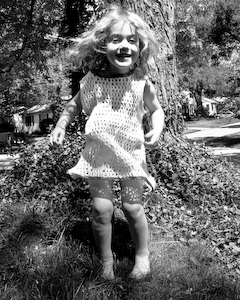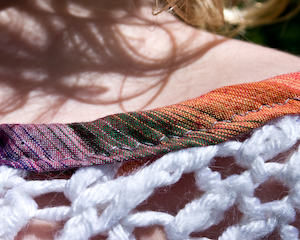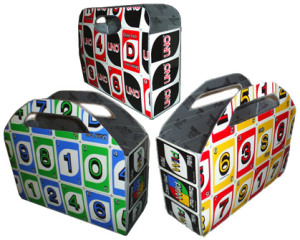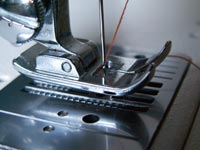Got a favorite afgan or other knit piece? Here’s how to sew with knitted or crocheted fabrics without things falling apart.

I am cheap. Cheap, cheap, cheap. Oh, and also eco-friendly, but mainly just cheap.
My favorite thing about the DIY lifestyle is that it’s also a thrifty lifestyle. It’s inspiring to take an unwanted, perhaps even damaged material something that someone else might discard or donate, and turn it into something that’s beautiful and useful again.
Take those sweet, knitted or crocheted afghans that I’m always coming across in thrift stores or dumpster-diving, or that often get re-gifted to me because I like handmade stuff.
I respect the love and time that goes into the act of knitting and crocheting, and the dedication, especially, that it takes to create an entire afghan, but frankly, I have enough of my own already, and I don’t necessarily need another one, especially if it’s just so-so or (gasp!) ugly.
An entire afghan, though? That’s a nice, large swatch of material to work with. I’ve been sewing up a storm with my thrifted and re-gifted afghan stash, lately, making some simple summer dresses for my little girls. Here are some tips so that you, too, can sew with knitted or crocheted materials–it’s not as tricky as it seems:

Tip #1: Use the sturdiest stitch in your arsenal. When sewing two pieces of knitted or crocheted material together, overlap them by half an inch and sew them together with a narrow zigzag stitch, or even an ex stitch–you’re not going to catch both pieces of fabric with every single stitch, especially if your fabric is very open weave, so the more thread you throw at your stitch, the more fabric you’ll catch.
Tip #2: Match your thread perfectly. Your stitches won’t look as neat as they would if you were sewing together two pieces of quilting cotton, but this won’t be noticeable if you match your thread perfectly.
Tip #3: Cut, then sew. Don’t give your fabric time to unravel by cutting out a piece, then sticking it on top of your pile of unfinished pieces for five months. Give yourself time to cut and sew your project today.
Tip #4: Cover your seams. Bias tape makes a neat finish for any raw edge (see this tutorial for how to hem with bias tape), but you can also use single-fold bias tape to cover any seam. For instance, I use double-fold bias tape to hem the neckline, armpits, and bottom hem of the dresses I make my girls out of afghans, but I use single-fold bias tape to cover the side seams and shoulder seams where I’ve sewn afghan fabric to afghan fabric. Doing so keeps any raw bits from unraveling, gives a neater look to the seam, and keeps the open-weave material from stretching too much when it’s worn.
Tip #5: Knitted and crocheted fabric is stretchy, but forgiving. Sew it to take advantage of its benefits. It drapes well, is easy to pull on and take off, and is stretchy and comfortable. It won’t hold an intricate or complicated shape well, it can be heavy, and you can see through it. Remember that before you make yourself a cute little top or a pair of pants or whatever.
Remember, too, that my girls and I aren’t sensitive to certain fabrics. We can happily use and wear afghans of indeterminate origin, because we’re fine with cottons, synthetics, and wools. If you’re not so lucky, you’ll have to be more careful, obviously.
What do you do with your extra afghans?







THANK YOU SO MUCH for this–I often wondered if, or how, this could be done. I would love to be able to knit–I’ve tried and tried, to no avail. But to be able to give a new life to knitted or crocheted items is the next best thing!
Most block motif and “mile a minute” strip afghans can also be taken apart and the pieces sewn with no cutting. I find granny square afghans more often than any other kind, but the other day I ran across a fabulous lacy hexagon block afghan that would really make a cute tunic.
Aw, thanks! I have a very intricately knitted sweater made by my grandma that no one will ever wear again, that I would like to make into pillows. This post has given me more courage to cut!
This is awesome – thanks for the tips!!
Pingback: Sew Old Afghans into New Clothes | Croq Zine - The Blog
Oh great, I’d been wondering if I could only sew with felted (fulled) wool garments. I’ve got an item I’d like to cut into… now I’ll give it a go.
Ooh, and another tip I wanted to add–if you’re making something that will be washed (like my little-girl dresses), go ahead and give it an extra pre-wash after you’ve sewn it but before you’ve worn it or given it away. If you happen to have missed a piece of cut yarn in your sewing, it will have raveled up a little in the wash, enough that you can notice it and fix it but not enough to ruin your item.
Pingback: Think Outside the Fabric Box: How to Sew with Knitted or Crocheted Fabrics «
This is a great way to design on purpose or by accident! Crocheters can make a giant swatch and then use their sewing machine to turn it into a shaped garment. I love the bias tape look too. Thanks!
Love this idea! Anybody have an idea how to repurpose my husband’s cashmere jacket with holes in the elbows? I can’t donate it since it has holes, he’s not a professor so I can’t patch them, and the thought of throwing away all that beautiful cashmere is killin’ me! Any ideas would be much appreciated!
Jen, maybe try taking the cashmere coat apart and using the pieces for a tailored skirt. I know how you feel about cashmere…its like gold 🙂
Or you could just snuggle in it–ooh, cashmere!
Thank you so much for this post!! I am trying to make my husband a pair of pants out of an afghan…he is sort of free spirit. LOL. Any tips besides the ones above? My plan is to take a pair of his pants and cut out the front and back from the afghan and then so them together….any input you could give me would be very, very much appreciated. Do you think I should put bias tape on the seams (outside/inside)?
I think bias tape is probably necessary for all the seams, especially for pants–the dress that I made didn’t have a lot of stress against the seams, but pants will, and bias tape will make sure that all those yarn ends can’t unravel.
Since I wrote this tutorial, I’ve also developed a major love affair with fabric stiffener, which is actually pretty easy to make yourself. It might be worth experimenting with stiffening the heck out of the afghan before you cut and sew it.
I would love to see a video of this in action. If any of you talented ladies ever get a chance?
Hello! This is so wonderful and super helpful, thank you! I personally am attempting to make a large patchwork “quilt” out of all my afghans and was wondering if you think I need bias tape on all the stitches? (in case its hard to imagine I am cutting the afghans into squares and then sewing all the squares together, attempting to keep finished edges on the edge, though this too is a puzzle)
Hi! I too love repurposing gems. Wondering if you have any tips for the pucker. When I sew machine Afghan pieces together I can get a pucker. Does the bias tape help? Thank you for any advice